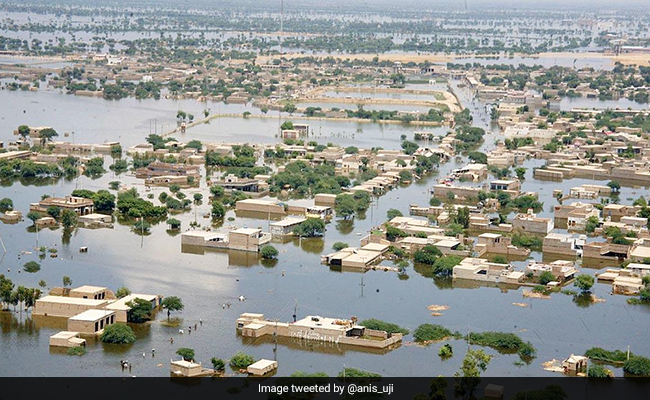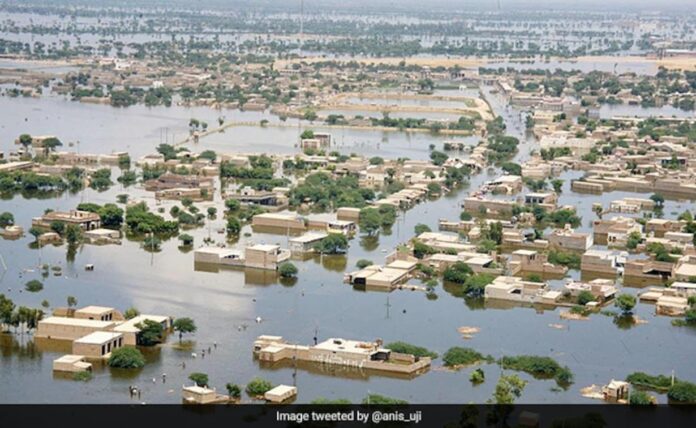)
by Dr Priyanka Mallick 7 September 2022
Floodplains are considered the most suitable place for human settlement. As a result, most ancient civilisations flourished on the floodplains of large rivers. Pakistan is the land of the great Indus Valley civilisations. Unfortunately, these days Pakistan is facing one of the worst floods in the current time. Over 1000 people are killed, and more than 33 million are affected due to climatic disasters. According to reports, around 110 of the 150 districts in the nation are impacted. In the last few weeks, Pakistan has experienced historic rainfall breaking the records of many years. According to the National Disaster Management Authority, Pakistan received 166.8 mm of rain in August, compared to the average of 48 mm, a 241 per cent increase. Corresponding to the Dawn news, Sindh and Baluchistan are the worst-affected regions, experiencing 784 per cent and 496 per cent increases in monsoon floods, respectively.
Sherry Rehman, Pakistan’s climate change minister, stated that while the country typically receives three to four spells of torrential rains yearly, it has already been hit by eight monsoon spells this year. According to Muhammad Fahim Khokhar, a Pakistani researcher, climate change also played a role in this year’s monsoon season. Since 2010, the monsoon belt of Pakistan has had an average annual temperature increase of 0.18 degrees. Warmer air can hold more moisture, resulting in heavier rainfall and flooding. The Government has declared a national emergency in Pakistan as the flood havoc increased unprecedently.
Impact on Economy
Most South Asian countries are already experiencing economic crisis, high inflation, and currency depreciation. The situation in Pakistan is deplorable. Pakistan has been experiencing double-digit inflation for months, owing to rising food and fuel prices. According to the current report published by the Pakistan Bureau of Statistics (PBS), inflation in Pakistan has surpassed 27 per cent yearly, the highest level since November 1973. Its currency has fallen as its foreign reserves have depleted. It is also estimated that these deadly floods cost more than $10 billion. According to Ahsan Iqbal, the planning minister, this preliminary estimate is likely to be much higher.
Infrastructures like roads, bridges, hospitals, schools, buildings, and houses are destroyed. Pakistan is an agrarian economy. These floods badly hit agricultural productivity and output. The agricultural sector is in disarray. Many vital areas that have been entirely wiped out under flood water are cotton crops, rice, and vegetables. They also threaten wheat and edible oil planting in the coming months, as flash floods take months to recede, causing a delay in the cultivation of wheat and edible oil. Pakistan’s food security is becoming apparent. The world cannot afford another disruption in the wheat supply.
International Response
Pakistan appeals to the international community and friendly countries for material and financial assistance. Pakistan and the UN appealed for $160 million as emergency funding for nearly half a million displaced people. The IMF has approved Pakistan’s long-awaited $1.17 billion as a part of the seventh and eighth tranches of Pakistan’s bailout accord that entered in 2019, but the release had been on hold this year. World Bank also announced $350 million in flood relief funding. The UK government has also stated that it provides immediate life-saving assistance to Pakistan in the aftermath of devastating floods. GBP 15 million will provide shelter and basic necessities to people across the country. In addition, the USA announced $30 million in life-saving humanitarian assistance to support people and communities affected by severe flooding in Pakistan. Furthermore, China, Saudi Arabia, Qatar, Turkey, Uzbekistan, the UAE, and other nations have generously donated to the disaster appeal and assisted Pakistan.
India’s Response: Is it the beginning of new ties?
Indian Prime Minister Mr Narendra Modi tweeted to extend “heartfelt condolences” to the victims of the floods in Pakistan. In reply to this, the PM of Pakistan, Mr Shehbaz Sharif, thanked Indian PM. Furthermore, Pakistan’s Finance Minister Miftah Ismail said in an interview that the Pakistani Government could consider opening a trade route with India for vegetables and other essential commodities via the Wagah border. Trade between India and Pakistan has been banned since the revocation of article 370 in 2019. He stated that international agencies had approached the Government about allowing imports from India through the country’s land border. Afterwards, several trades and business personnel also demanded to open land border trade with India to reduce transportation charges, which will help consumers get vegetables and fruits at cheaper rates. However, Pakistan’s Government still has not reached out to India for assistance. India would provide them humanitarian aid like India is doing in other countries.
There is a famous saying that shared water can be used as a source of conflict or a catalyst for cooperation. Only the future will say whether these flood waters will be able to melt the frozen relationship between India and Pakistan. However, there are some positive developments. Mr Jaishankar, the foreign minister of India, in an event organised by Asia Society Policy institute, spoke about the importance of regionalism in South Asia. He said, “India actually being more generous and more non-reciprocal and more effective in what is building.” However, India’s generosity and non-reciprocity nature should not be considered a weakness of India. Several times, India had helped Pakistan during the crisis, whether the 2005 earthquake or the 2010 floods, with both material and financial assistance. Nevertheless, Pakistan still provides shelter to terrorist organisations. No persecution or punishment for the culprits of terror attacks in India.
India and Pakistan not only share the same historical and cultural linkages, but their climatic condition and weather variations are also striking. Both face the adversaries of climate change, whether the glacial melt or the uneven rainfall pattern results in floods and droughts. The Subcontinent’s ecological continuity strengthens the need for regional collaboration on climate-related issues. The land borders also help to provide quick relief materials at the time of any crisis. A cooperative mechanism during a crisis is a win-win situation for both countries.

